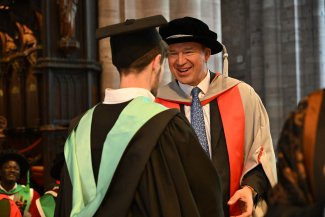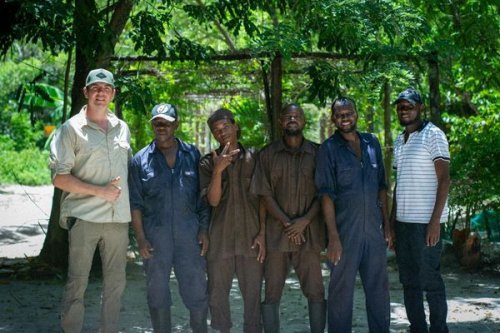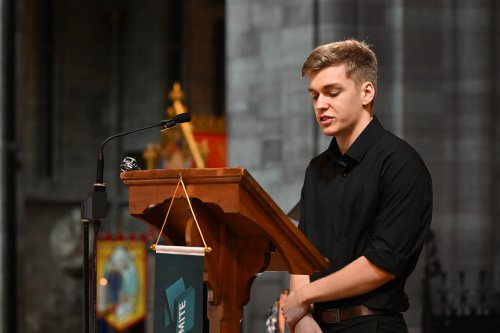Rt Hon Jesse Norman MP, Chair of NMITE
Eight hundred years ago, there was a huge dust-up in Oxford, and some of the scholars there decided to leave. As they walked out, they came to a crossroads.
They could have turned left, travelled 90 miles and set up in Hereford. Instead they turned right, travelled 90 miles and founded Cambridge University.
One can see why. Herefordshire at the time was something of a war zone. The Cathedral had been burnt down by Welsh raiders around the time of the Norman Conquest, and it had taken a century to be rebuilt. The Marcher Lords built their castles to keep out those marauding Welshmen.
But even so, Hereford was known to have a community of scholars, and they were based around this building, the Cathedral.
Over time things started to calm down. In the year 1189 Hereford received its civic charter – you can still see it in the Town Hall. And academically, these scholars of Hereford were building a national reputation for the city.
They specialised in all the seven liberal arts: the mediaeval trivium of grammar, logic and rhetoric, which trained them to reason, communicate and argue effectively; and the quadrivium of arithmetic, geometry, astronomy and music, which trained them in what we would now call pure and applied mathematics.
Hereford had particular expertise in applied mathematics. By the early 13th century, around the time of Magna Carta – the 1217 edition of which you can see only a few yards from here – Hereford was becoming a centre for the applied sciences.
It had expertise in the use of instruments such as the abacus and astrolabe, and in computational methods such as those used to determine astronomical tables. Indeed the scholar known as Roger of Hereford had composed a set of astronomical tables in 1178 around a meridian placed in Hereford.
Just think of what might have happened if those Oxford scholars had turned left and not right, and if Roger of Hereford’s astronomical tables had been widely adopted.
We can say one thing for sure: the traffic here would be even worse.
And the world’s navigation would be tied today not to the Greenwich meridian, but the Hereford meridian. We would be setting our watches and phones to HMT – Hereford Mean Time – not GMT.
Hereford really would have been the centre of the world, as every Herefordian secretly believes today. Not only that: since everyone then thought the stars rotated around the Earth, Hereford would have been the centre of the universe… as every Herefordian secretly believes today.
But then, nothing. This great scholarly tradition died out.
Two universities grew up, in Oxford and Cambridge, which vigorously and effectively suppressed any new universities in England for six hundred years. There were five universities, five, in Scotland, which spawned Adam Smith, David Hume and the Scottish enlightenment.
England had UCL and Kings in London in the 1820s, then a rush of Victorian universities, then steady growth in the twentieth century, then a sudden expansion of universities in the 1960s, and again more recently.
But in Herefordshire, there was nothing, for more than eight hundred years. Thirty generations of young people grew up in this county with no local university to go to, or to bring others in.
And since universities have always been huge sources of economic growth, the county missed out on that economic growth as well.
Ladies and Gentlemen, think of all that talent unrealised, that lost opportunity, that gigantic human and economic potential squandered. And even today, in 2025, that same deep unfairness still persists. Across the UK, 50 per cent of school leavers go to university. In the South-East, it’s 70 per cent. In Herefordshire, it’s just 18 per cent.
Until now. Our mission at NMITE is to change all this. We want to create phenomenal opportunities for young people from here and elsewhere. But not only that: we want to change the nature of university education itself, to make it far more ambitious and effective.
What does that mean?
Not just marginal educational gain, but transformational improvement: to take someone, male or female, young or old, who might never have thought of going to university at all, help them find their passions, head, hands and heart, and take them as far they can go.
To reinvent not just what our students learn, but how they learn. To tie theory and practice together in real-world challenges. To forge professionals through immersion, intensity, and purpose. To build the right habits and prepare them not only for the world of work, but for a world in which work itself is constantly changing.
To keep the benefits of being small in size: the agility, the accountability, the personal engagement, the teamwork, the friendships, the sense of belonging and community, so that our students grow as morally serious human beings, who can readily and resiliently deal with complexity and uncertainty, and who are deeply aware of the power and responsibility that comes with being an engineer.
Let me be clear. We do not want to create spectators, or commentators, or people who are merely critical thinkers. We do not want to be huge or hierarchical or high cost. Other universities can do that.
No: we will go our own way. We want to create doers, people of real capability, who never stop learning, who never stop thinking, people of independent mind and purpose, who will go out and change our world for the better. That is the mission of NMITE.
Let’s not forget that original 2021 NMITE pitch: come to a university that doesn’t exist, in a city you’ve never heard of, to do a brand new and untested course, for a completely unknown economic outcome.
How could any student, how could any parent, refuse such an enticing and seductive opportunity?
But of course, the real pioneers, the real risk takers, saw the opportunity – and they took it.
So I say to all you families and friends: thank you for backing these amazing young people to come here, and thank you for placing your trust in us. You and they had the courage to choose a different path.
I say to our brilliant staff, trustees and partners, past and present: thank you for your commitment, for your imagination and your drive, and for the superb work you have done. This is Act 1: the end of the beginning. Now the real work of growth begins.
I say to our donors and supporters, and everyone gathered here today: remember those 800 empty years, those 30 generations of lost opportunity in Herefordshire.
Please continue to give us your unstinting help and support, so we can honour the memory of those countless thousands of local people who were never given the opportunity they deserved. Help us now to make this foundational investment in future generations.
And finally, I say to our miraculous graduates: you are NMITE’s founding generation. Others will follow – but you were the first. You were the first.
Those Oxford scholars turned right. But you, graduates, staff, families, you turned the other way. You chose something new. Something harder. And something in many ways even better.
My father used to say that the secret of success is to take a large bite, and chew it.
Wherever you go, carry with you this mad, bold, beautiful experiment we call NMITE, live your lives with courage and joy and energy, and make us proud.
Ladies and Gentlemen: three cheers for NMITE and its first graduating class!







